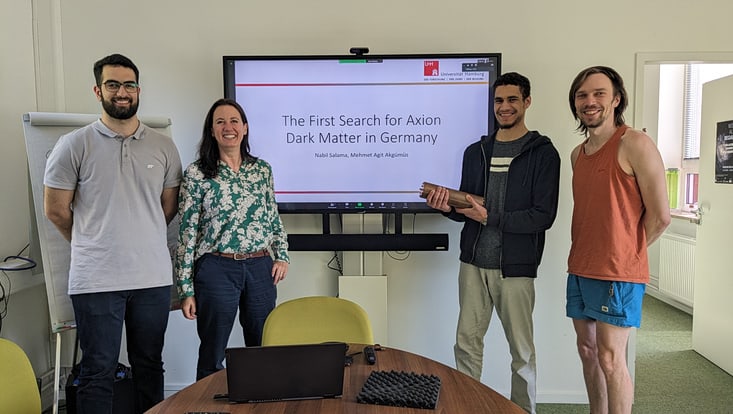Axion Cavity Experiment SPACEStudent project sets new limit for Axion Dark Matter
6 August 2025
A search for axion dark matter, this ambitious endeavor was successfully taken by the "Student Project for an Axion Cavity Experiment" (SPACE) research group of Mehmet Agit Akgümüs and Nabil Salama at the Institute for Experimental Physics of the University of Hamburg. After more than one year of research and development on their own, the students were able to set a new exclusion limit for a theoretical dark matter particle named Axion at a mass around 16.6 µeV. The project was funded with 10.000 Euros as part of the Excellence Strategy at the University of Hamburg through the HUB for Crossdisciplinary Learning (HCL).
Dark matter constitutes one of modern physics' most mysterious problems, with astrophysical observations suggesting it makes up approximately 80% of the universe's total mass. Despite its apparent abundance, dark matter has not been directly detected yet due to its weak interaction with regular matter and it could completely consist of the hypothetical axion particle.
Axions can interact with a strong external magnetic field and convert into photons, which can then be enhanced in a resonant cavity. They can be detected by a small antenna inside the cavity and this signal can then be amplified with a receiver chain, thus making axion detection possible. This experimental method follows an already established approach for axion dark matter detection, that is also used by other dark matter experiments like ADMX and HAYSTAC. The student researchers adapted this approach and optimized the cavity size to be sensitive in a yet unexplored axion mass range. After designing the cavity, they got it produced using a high precision wire EDM machine, at the Mechanical Workshop of the Physics Department of the University of Hamburg.
The cavity is placed within a superconducting magnet, providing a field of 14 T, which is almost 300,000 times stronger than the earth magnetic field and stronger than the magnets used in magnetic resonance imaging (MRI) of about 2 Tesla. A receiver system then extracts and amplifies the signal, which is digitized using an ADC board, that was provided by the MADMAX experiment (Science City Hamburg Bahrenfeld) and ran with firmware from the BREAD collaboration (Fermi National Accelerator Laboratory, Fermilab, USA).
It turned out that the SPACE experiment is the first Axion search experiment of this kind carried out in Germany, which makes Mehmet Agit Akgümüs and Nabil Salama particularly proud. The team succeeded in setting new exclusion limits on the axion-photon coupling constant for a specific axion mass range. Although the Axion was not detected, the results contribute to constraining the parameter space of axions. The new limit is less sensitive and covers a smaller area of possible Axion mass compared to other leading experiments. Looking forward, these could be improved by placing the experiment inside a cryostat to reduce noise or making small changes to the cavity geometry, to shift the resonance frequency.
Throughout the project, the project team learned the designing of high-frequency cavities, handling of different electronic components for the radio frequency (RF) readout system and analyzing the signal to get proper results. “This practical experience was an exciting first insight into working in experimental physics. It has been a very rewarding experience, teaching us a lot about planning and executing an experiment”, says Nabil Salama.
Besides the funding through the HCL, the SPACE project benefited greatly from the resources and support provided by the Cluster of Excellence Quantum Universe. “We were greatly mentored by Dr. Jacob Egge and Prof. Dr. Erika Garutti. We would also like to thank the mechanical workshop of the physics department, who helped us producing the cavity, the Institute of Experimental Physics for providing the 14 Tesla Magnet and everyone who got involved and supported our project”, says Mehmet Agit Akgümüs.
This project was funded under the Excellence Strategy of the Federal Government and the Federal States.




